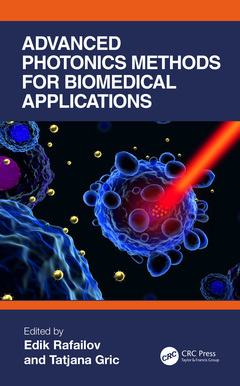Advanced Photonics Methods for Biomedical Applications
Coordonnateurs : Rafailov Edik, Gric Tatjana

Advanced photonics methods for biomedical applications give researchers in universities and industries, and clinicians an overview of the novel tools for cancer diagnostics and treatment. This book provides researchers and professionals in the area of biomedical photonics with a toolbox of novel methodologies for biomedical applications, including health diagnostics, cancer detection, and treatment. It covers the theory, modeling, and design of each method, alongside their applications, fabrication, characterization, and measurements in clinical practice. A wide scope of concepts concerning innovative science and technologies of medicine will be covered, providing the readers with the latest research, developments, and technologies. It will also be a valuable resource for students and early-career researchers, alongside those involved in the design of the novel photonics-based techniques for health diagnostics and cancer detection and treatment.
Key features
? Discusses novel methods of cancer diagnostics and cancer treatment.
? Details non and minimally invasive photonics techniques.
? Explores the applications of machine learning and artificial intelligence to these novel techniques.
Edik Rafailov received the PhD degree from the Ioffe Institute in 1992. In 1997 he moved to St Andrews University (UK) and in 2005 he established a new group at Dundee University. In 2014 he and his Optoelectronics and Biomedical Photonics Group moved to Aston University (UK). He has authored and co-authored over 450 articles in refereed journals and conference proceedings, including two books, ten invited chapters, and numerous invited talks. He coordinated the €14.7M FP7 FAST-DOT project development of new ultrafast lasers for biophotonics applications and the €12.5M NEWLED project, which aims to develop a new generation of white LEDs. He coordinates the H2020 FET Mesa-Brain (which aims to develop 3D nano-printing technology for functional three-dimensional human stem cell-derived neural networks), NEUROPA (which aims to develop novel non-invasive theragnostic approaches), the H2020 PLATFORMA project, and the EPSRC (EP/R024898/1 proposal. He also leads a few other projects funded by the EU and EPSRC (UK). His current research interests include high-power CW and ultrashort-pulse lasers; generation of UV/visible/IR/MIR and THz radiation nanostructures; nonlinear and integrated optics; and biomedical photonics.
Tatjana Gric’s research career has been focused on the investigation of waveguide devices (waveguide modulators, filters etc.), namely on proposing their electrodynamical analysis. Applied research includes the design of microwave frequency selective structures, waveguide modulators, and filters. Fundamental research is primarily concerned with developing rigorous computational methods for the electrodynamical analysis of the waveguide structures. Another major goal of her studies is plasmonics as the examination of the interaction between electromagnetic field and free electrons in a metal. The optically active nanostructures have been simulated and their fundamental photonic properties have been explored. Moreover,
Date de parution : 07-2023
15.6x23.4 cm
Thèmes d’Advanced Photonics Methods for Biomedical Applications :
Mots-clés :
cancer diagnostics and treatment; medical diagnostics; microscopy; spectroscopy; neurophotonics; PDT; Machine Learning; Artificial Intelligence; AI; Biological Tissue; Stokes Vector; THz Imaging; THz Pulse; THz TDS System; THz Radiation; Mm Element; Effective Permittivity; CCD Spectrometer; Mm Image; Effective Medium Approximation; Mm; Fiber Optic Configuration; Complex Dielectric Spectrum; DE Algorithm; Integrated Absorbance; NIR Spectroscopy; Pork Sample; THz Spectroscopy; Cole Cole Models; Fluorescence Spectra; THz Frequency; Fluorescence Intensity; Hyperspectral Camera; Higher Filling Fractions



